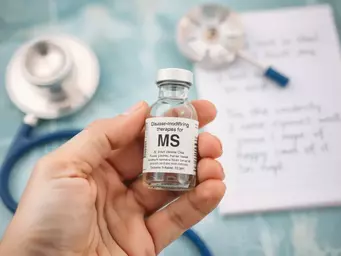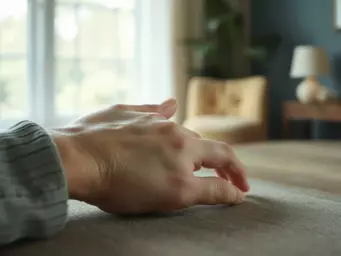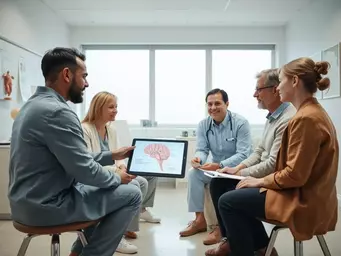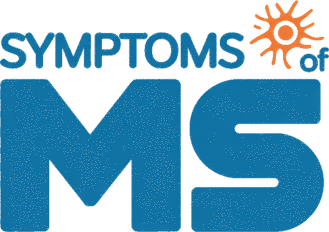Managing MS Symptoms Through Therapy

Research shows that engaging in tailored therapy can drastically improve the quality of life for individuals with multiple sclerosis. Have you considered how physical and occupational therapy might transform daily challenges into manageable tasks?
What You Will Learn
- Physical therapy enhances mobility and reduces pain through customized exercise programs.
- Strength training and aerobic exercises build endurance and help combat MS-related fatigue.
- Occupational therapy focuses on adapting daily living activities and environments for greater independence.
- Individualized therapy plans address unique patient needs, leading to improved functional independence.
The Dual Roles of Physical and Occupational Therapy in MS Management
Physical and Occupational Therapy are vital in managing Multiple Sclerosis symptoms, focusing on improving physical function and daily living activities to enhance overall quality of life.
Physical Therapy: Enhancing Mobility & Reducing Pain
Focuses on improving physical function, strength, balance, and reducing discomfort.
- Strengthening exercises
- Balance training
- Pain management strategies
- Gait and flexibility exercises
Occupational Therapy: Enhancing Daily Living Activities
Aims to help individuals perform daily tasks more effectively and maintain independence.
- Adaptive techniques for tasks
- Energy conservation methods
- Home environment modification
- Assistive device recommendations
Understanding the Role of Physical and Occupational Therapy in Managing MS Symptoms
As someone who has dedicated years to understanding multiple sclerosis (MS), I can tell you that both physical and occupational therapy are crucial in managing the symptoms of this complex condition. These therapies not only help improve physical function but also enhance quality of life for those living with MS. Let’s delve into how each type of therapy plays a significant role in symptom management!
How Physical Therapy Supports Mobility and Reduces Pain in MS
Physical therapy focuses on enhancing mobility and relieving pain through various techniques. With MS, individuals often face challenges like muscle weakness, balance issues, and fatigue. Luckily, physical therapists specialize in developing tailored programs that address these specific challenges!
- Assessment of individual mobility needs
- Strengthening exercises to build muscle
- Balance training to reduce fall risk
- Pain management strategies including modalities like heat and cold therapy

By implementing these strategies, physical therapy can lead to improved mobility and a reduced perception of pain, allowing individuals to navigate their daily lives with greater ease.
Overview of Physical Therapy Techniques for MS
Techniques used in physical therapy for MS often include a combination of manual therapy, strength training, and aerobic conditioning. By engaging in these methods, patients can significantly enhance their functional abilities. Each technique is designed to be adaptable, ensuring that the patient's needs are met regardless of their physical condition.
Benefits of Strength Training and Aerobic Exercises
Strengthening muscles is essential for anyone with MS. It not only builds endurance, but it also helps combat the fatigue that often accompanies this condition. Consider adding strength training and aerobic exercises to your routine, as they can lead to:
- Increased muscle strength
- Enhanced cardiovascular health
- Improved balance and coordination
These benefits can ultimately lead to greater independence and a more active lifestyle!
Mobility Training Strategies for Enhanced Movement
Mobility training is a vital component of any physical therapy plan for MS. Strategies may include gait training, flexibility exercises, and balance activities. By focusing on these areas, individuals can experience:
- Improved walking patterns
- Increased range of motion
- Reduced stiffness and spasticity
By investing time in mobility training, patients not only enhance their physical capabilities but also boost their confidence in daily activities.
Occupational Therapy for Enhancing Daily Living Activities
Occupational therapy plays a unique role in helping individuals with MS engage in their daily activities more effectively. This type of therapy emphasizes adapting the environment or the way tasks are performed to improve overall function. For many, this can make all the difference!
- Assessment of daily living skills
- Development of adaptive techniques for common tasks
- Education on energy conservation methods
- Support in modifying the home environment
These strategies empower individuals to take charge of their daily routines, ultimately enhancing their quality of life.
Adaptive Strategies for Managing Fatigue and Spasticity
For those living with MS, managing fatigue and spasticity is critical. Occupational therapists can introduce adaptive strategies that allow individuals to perform tasks more efficiently without overexerting themselves. Simple adjustments, such as using a shower chair or installing grab bars, can significantly ease daily challenges. Further insights into managing MS symptoms and treatment guidelines can be found on Neurology Advisor.
Use of Assistive Devices and Adaptive Equipment
Assistive devices and adaptive equipment are invaluable resources for individuals with MS. They can help in maintaining independence while managing physical limitations. Some common tools include:
- Canes and walkers for improved stability
- Kitchen tools designed for easier gripping
- Adaptive computer software for improved communication
These devices not only enhance performance but also promote a sense of autonomy in everyday life!
Individualized Therapy Plans for Functional Independence
Every person's journey with MS is unique, which is why individualized therapy plans are vital. Occupational therapists work closely with patients to create customized plans that focus on enhancing their ability to perform daily tasks, ultimately fostering functional independence. This tailored approach ensures that each patient's specific needs and goals are addressed effectively. Recent research, such as articles published in Frontiers in Neuroscience, highlights the importance of personalized interventions in neurological conditions.
At Symptoms of MS, we believe that understanding and utilizing the benefits of both physical and occupational therapy can empower individuals to manage their MS symptoms more effectively. Let's continue to explore how to apply these insights to improve overall well-being!
Pro Tip
Did you know? Integrating simple stretching routines into your daily life can greatly enhance your flexibility and reduce stiffness associated with MS. Just a few minutes each day can lead to significant improvements in mobility and overall comfort.
Frequently Asked Questions About MS Therapy
What is the main goal of physical therapy for MS patients?
The main goal of physical therapy for MS patients is to enhance mobility, reduce pain, improve strength and balance, and address challenges such as muscle weakness and fatigue through customized exercise programs and techniques.
How does occupational therapy help individuals with MS?
Occupational therapy helps individuals with MS by focusing on adapting daily living activities and environments. This includes developing adaptive techniques for tasks, educating on energy conservation, and supporting home environment modifications to improve overall function and independence.
Can strength training and aerobic exercises benefit MS patients?
Absolutely. Strength training and aerobic exercises are highly beneficial for MS patients as they help build muscle strength, enhance cardiovascular health, improve balance and coordination, and combat MS-related fatigue, leading to greater independence.
Why are individualized therapy plans important for MS management?
Individualized therapy plans are crucial because every person's experience with MS is unique. These plans are tailored to address specific symptoms, needs, and goals of each patient, ensuring the most effective strategies for enhancing functional independence and quality of life.
What role do assistive devices play in MS therapy?
Assistive devices and adaptive equipment are invaluable for individuals with MS. They help maintain independence by providing support for mobility (e.g., canes, walkers), making daily tasks easier (e.g., specialized kitchen tools), and promoting autonomy in everyday life.
Recap of Key Insights on Managing MS Symptoms with Therapy
As we wrap up our discussion on managing multiple sclerosis, it's important to reflect on how physical and occupational therapy can make a significant difference in your journey. These therapies are not just about addressing symptoms—they’re about enhancing your overall quality of life! From improved mobility to reduced pain, the benefits are evident when you engage actively in your care.
Incorporating therapy into your routine can lead to long-term outcomes that positively affect your daily life. By understanding the various techniques and strategies available, you empower yourself or your loved ones to tackle the challenges MS presents head-on.
Final Thoughts on the Benefits of Physical and Occupational Therapy
It's vital to recognize that the benefits of therapy extend beyond immediate symptom relief. Through consistent engagement, patients often experience significant long-term outcomes, which include:
- Improved physical function and strength
- Reduced fatigue and pain
- Enhanced emotional well-being
- Greater independence in daily activities

As someone deeply involved in the MS community, I encourage you to seek professional guidance and support from certified therapists. Their expertise can help tailor a program that fits your unique needs and lifestyle, making a world of difference in your management of MS.
Encouragement to Seek Professional Guidance and Support
Therapy isn’t a one-size-fits-all approach, and having a team of professionals by your side can be a game changer. They can provide individualized plans that take into account your specific symptoms and goals. Remember, you’re not alone in this journey—resources are available, and I highly recommend utilizing them for the best outcomes.
Next Steps for Individuals with MS: Getting Started
So, what comes next? Taking the initial steps towards therapy can seem overwhelming, but I assure you, it’s worth it! Here are some practical steps to help you get started:
- Research and find qualified therapists who specialize in MS.
- Consider programs that offer both physical and occupational therapy.
- Look into support groups that provide community and encouragement.
These resources can guide you on your path to better management of your symptoms and overall health. Don’t hesitate to reach out for guidance—your journey towards a more fulfilling life with MS begins here!
Resources for Finding Qualified Therapists and Programs
When searching for the right therapy options, consider the following resources:
- Local hospitals or rehabilitation centers
- Professional associations for physical and occupational therapy
- Online directories that specialize in MS care
Utilizing these resources can help ensure you find providers who understand the complexities of MS and can support your specific needs.
Downloadable Guides and Tools for Home Management
At Symptoms of MS, we strive to offer practical tools for managing your condition effectively. Keep an eye out for our downloadable guides that cover:
- Daily exercise routines
- Energy conservation techniques
- Strategies to manage fatigue and spasticity
These materials can complement your therapy sessions and provide ongoing support as you navigate your MS journey.
Telehealth Services as a Convenient Therapy Option
Finally, let’s talk about the convenience of telehealth services. They can be a fantastic option for those who may find it difficult to attend in-person sessions. With telehealth, you can:
- Access therapy from the comfort of your home
- Schedule sessions at times that work for you
- Remain consistent with your therapy without added stress
Incorporating telehealth into your treatment plan can provide flexibility and ease in managing your care. Remember, taking charge of your health is empowering!
Recap of Key Points
Here is a quick recap of the important points discussed in the article:
- Physical therapy is essential for improving mobility, reducing pain, and enhancing overall physical function in individuals with MS.
- Occupational therapy focuses on adapting daily living activities and environments, significantly improving quality of life.
- Incorporating strength training and aerobic exercises into your routine can boost endurance and help combat fatigue.
- Individualized therapy plans are critical for addressing the unique needs of each person living with MS.
- Utilizing assistive devices and adaptive equipment can promote independence and ease daily challenges faced by those with MS.









